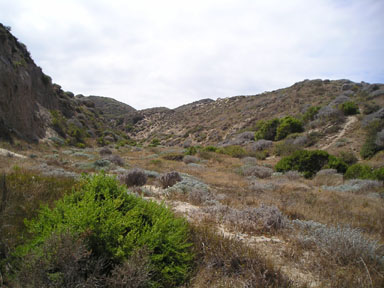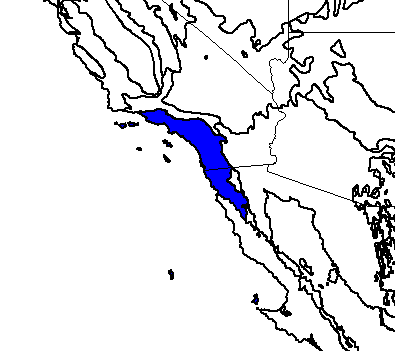
Canyon on Santa Rosa Island, California (c) 2005 Natasha Sherman
Bioimages home (click on an image to enlarge)
view
this page in its intended navigation context
California coastal sage and chaparral (WWF
ecoregion NA1201)

Canyon on Santa Rosa Island, California
(c) 2005 Natasha Sherman

Source of bioregions data:
Olson, D. M. and
E. Dinerstein. The Global 200: Priority ecoregions for global conservation. (PDF
file) Annals of the Missouri Botanical Garden 89:125-126.
Distinctiveness (1=highest,4=lowest): 1
(globally outstanding)
This ecoregion includes diverse and globally rare habitat types. A large
number of endemic species of plants and animals are present. Habitats
include chaparral, oak woodlands and conifer woodlands. The ecoregion has
over 150 species of butterflies and the highest species richness of native
bees.*
Conservation Status (1=most endangered, 5=most
intact): 1 (critical)
Only 15% of the coastal sage scrub remains and most oak savannas have been
destroyed. The habitats are extremely fragmented due to intensive
development. Invasion of alien species, fire supression, grazing, and smog
are threats.*
Some views from the ecoregion
San Diego County, California


Santa Margarita Ecological Preserve, conifer community along Hwy. 79 (c)
2005 Natasha Sherman
hires
hires
Santa Cruz Island, Channel Islands, California





(l-r) central valley, Cherry Canyon, coastal
canyon, buckwheat along Navy Rd., view toward harbor
(c) 2005 Natasha Sherman
hires
hires
hires
hires
hires
Santa Rosa Island, Channel Islands, California







(l-r) Carrington Point, elephant seals on China
Beach, island interior, oak, coastal dunes, canyon, distant view of Torrey pines
(c) 2005 Natasha Sherman
hires
hires
hires
hires
hires
hires
hires
Coastal dune vegetation, Oxnard beach, Ventura Co., California




(c) 2005
Daniel P. Duran
hires
hires
hires
hires
* Ricketts, T.H., E. Dinerstein, D.M. Olson, C.J. Loucks, et al. (1999) Terrestrial Ecoregions of North America: A Conservation Assessment. World Wildlife Fund - United States and Canada. Island Press, Washington, D.C. pp. 337-340.